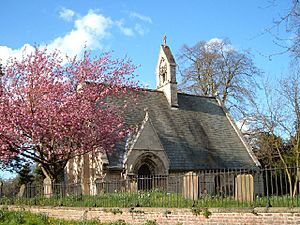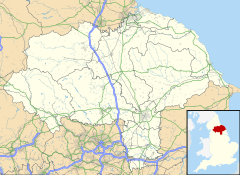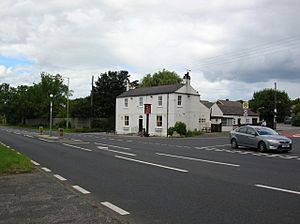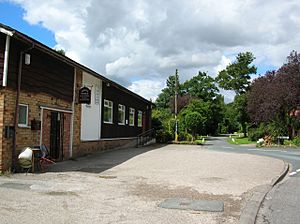Skelton, York facts for kids
Quick facts for kids Skelton |
|
|---|---|
 St Giles Church, Skelton |
|
| Population | 1,549 (2011 census) |
| OS grid reference | SE570561 |
| Civil parish |
|
| Unitary authority | |
| Ceremonial county | |
| Region | |
| Country | England |
| Sovereign state | United Kingdom |
| Post town | YORK |
| Postcode district | YO30 |
| Police | North Yorkshire |
| Fire | North Yorkshire |
| Ambulance | Yorkshire |
| EU Parliament | Yorkshire and the Humber |
| UK Parliament |
|
Skelton is a small village in North Yorkshire, England. It is part of the City of York area. Skelton is about 4 miles (6.4 km) north-west of the city of York. It sits on the east side of the River Ouse.
The village was once part of a large royal forest called Forest of Galtres. Skelton covers about 977 hectares (2,415 acres). In 1973, Skelton was made a special "conservation area." This means its history and natural beauty are protected.
The name 'Skelton' likely comes from an old Anglo-Saxon word. It probably meant 'the settlement on high ground'. Later, when the Danes arrived, the name changed to what we know today. Skelton is so old that it is even mentioned in the Domesday Book. This famous book was written in 1086.
In 2011, about 1,549 people lived in Skelton.
Contents
History of Skelton Village
Skelton has a long and interesting past. It is one of the places listed in the Domesday Book. This shows it was an important settlement almost a thousand years ago. Its name tells us about both Anglo-Saxon and Danish people living here.
Skelton Grange and Fairfield House
Skelton Grange was a large house built in the 1700s. The Place family owned it for many years. After a fire in 1866, it was rebuilt. The Grange was sold in 1981 because it was too expensive to keep up. Later, it was taken down to build new homes.
Fairfield House is another historic building in Skelton. In 1918, the York Corporation bought it. The next year, it opened as a special hospital. This hospital helped people who were very sick with a lung illness. Today, Fairfield House is a hotel.
How Skelton is Governed
Skelton is part of the City of York Council. This council is like the local government for the area. It makes decisions about local services and rules.
Local Representatives
The Skelton, Rawcliffe, and Clifton Without area has local councillors. These are people elected to represent the community. They help make decisions for the village. As of 2010, the councillors were from the Liberal Democrats and Conservative Party.
Skelton also has its own Parish Council. This council is made up of nine people. They are elected by the villagers. The Parish Council helps manage local issues. These can include things like village green upkeep or local events.
National Representation
For the UK Parliament, Skelton is part of the York Outer area. This means people in Skelton vote for a Member of Parliament (MP) for this area.
Population Changes in Skelton
The number of people living in Skelton has changed over time.
- In 1890, only 313 people lived here.
- By 1901, the population was 270. Most people worked on farms or in big houses.
- In 1951, there were about 481 residents.
- The population grew quickly after that. In 2001, it reached 1,640 people.
- The 2011 census showed 1,549 people living in Skelton.
What Skelton is Like Today
Skelton used to be mainly a farming village. Now, it is mostly a place where people live. There is a small area with shops and services. These include a post office, a general store, and a doctor's office. The village also has one pub and a social club.
Nature and Wildlife in Skelton
The older part of Skelton village is on higher ground. This area is about 25 metres (82 feet) above sea level. The rest of the village is lower. There are several ponds in Skelton. This shows that there is a lot of water underground.
Plants and Animals of Skelton
Surveys have looked at the plants and animals in Skelton.
- In 1956 and 1971, experts found many different species.
- They found 100 types of birds.
- There were 328 kinds of trees and plants.
- They also found 8 types of ferns and 31 types of moss.
- Amphibians like frogs, toads, and newts live here. This includes the special warty or crested newt.
- 21 types of mammals were recorded. These include the whiskered bat and the long-eared bat.
- The bats and crested newts in Skelton are protected species. This means they are very important and need to be kept safe.
Village Green Spaces
The Parish Council and local volunteers help look after the open spaces in Skelton. These areas include The Green, Crooking Green, and Orchard Field. Skelton Pond is another important green space. These areas are great for nature and for people to enjoy.
Getting Around Skelton
The main road west of Skelton is the A19. This road goes from York towards Thirsk. It has been an important route for a long time.
History of the A19 Road
In the 1700s, people tried to improve the road through Skelton. This was done by making it a "turnpike" road. This meant people had to pay to use it. The first attempts failed, but the plan worked in 1753. The turnpike system helped keep the road in good condition. It was used until 1874.
Bus Services
Skelton has several bus services. These connect the village to York and other towns. Some buses go to Easingwold and Thirsk. There is also a local bus service (Service 19). This bus goes into the village itself. It connects Skelton to Rawcliffe, Clifton, and York city centre.
Education in Skelton
A school was first built in Skelton in 1872. It could hold 120 children.
Today, children in Skelton go to Skelton Community Primary School. This school is located in Brecksfield. After primary school, students usually go to Vale of York Academy. This secondary school is in nearby Clifton Without.
Religion in Skelton
The main church in Skelton is St Giles' Church. It was built in 1247. The church is very old and has not changed much since it was built. It is known as one of the few complete "Early English" churches in the country. Many famous writers have mentioned it. These include Nikolaus Pevsner and John Betjeman.
Sports in Skelton
Skelton used to have a football team called Skelton Football Club. They played in a local league until 2010.
Important Buildings and People
Skelton has several historic buildings.
- St Giles' Church is a Grade I listed building. This means it is very important historically.
- Skelton Manor is a Grade II* listed building.
- Other Grade II listed buildings include Pyramid House and Skelton Hall.
- The old Toll Bar Cottage was built when the road became a turnpike.
- You can also see an old post-box from the time of King George VI. There is also a mounting block outside the Blacksmiths Arms pub. This was used to help people get onto their horses.
A famous person who lived in Skelton is the author Justin Hill. His family lived in the village from 1985 to 2004.





